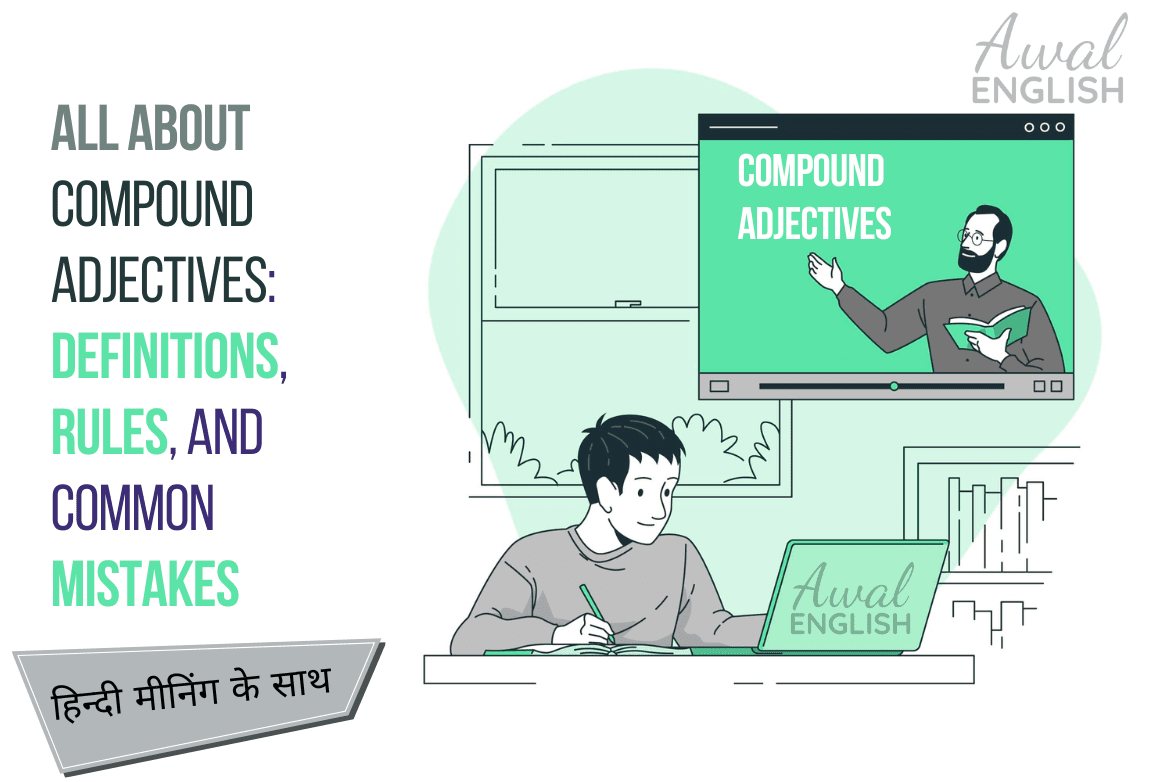
Compound adjectives are adjectives formed by combining two or more words, usually connected by a hyphen, to modify a noun together. These adjectives add precision and clarity to descriptions. For example, “well-known” describes something widely recognized, and “blue-eyed” refers to someone with blue eyes.
What is a Compound Adjective?
A compound adjective consists of two or more words that work together as a single adjective to describe a noun.. These words are often hyphenated to avoid confusion and ensure clear meaning. For example, “part-time” in “part-time job” indicates a job that is not full-time, and “high-speed” in “high-speed train” specifies a train designed to move quickly.
Compound adjective वह adjective होता है जो दो या अधिक words को जोड़कर बनाया जाता है और एक noun को modify करता है। अक्सर इन words के बीच hyphen का प्रयोग होता है ताकि meaning स्पष्ट हो। जैसे, “part-time” का मतलब है “पूरा समय नहीं,” और “high-speed” का मतलब है “तेज़ गति।”
Definition of Compound Adjective
A compound adjective is defined as two or more words combined, typically with a hyphen, to act as a single descriptive term before a noun. This structure enhances specificity and reduces ambiguity. Examples include “well-behaved” (describing good behavior) and “five-star” (indicating high quality).
Compound adjective को परिभाषित किया जाता है ऐसे दो या अधिक words के रूप में जो एक adjective के रूप में काम करते हैं और अक्सर hyphen के साथ जुड़े होते हैं। यह structure meaning को specific बनाता है और confusion को कम करता है। उदाहरण के लिए, “well-behaved” का मतलब है “अच्छा व्यवहार” और “five-star” का मतलब है “उच्च गुणवत्ता।”
Tricky Compound Adjective Examples
While compound adjectives add clarity, mistakes often occur in their usage, especially in hyphenation or word pairing. Here are examples of common errors with compound adjectives:
Compound adjectives clarity बढ़ाते हैं, लेकिन इनके use में, खासकर hyphenation और word pairing में, mistakes हो सकती हैं। यहां कुछ common mistakes के examples दिए गए हैं:
Well-Known/Well Known
Incorrect: “She is a well known artist.”
Correct: “She is a well-known artist.”
Hindi: “वह एक प्रसिद्ध कलाकार है।”
Note: Compound adjectives modifying a noun must have a hyphen (“well-known artist”).
Three-Year-Old/Three Year Old
Incorrect: “They have a three year old child.”
Correct: “They have a three-year-old child.”
Hindi: “उनका एक तीन साल का बच्चा है।”
Note: Numbers used as compound adjectives must include hyphens to indicate the full adjective applies to the noun.
Part-Time/Part Time
Incorrect: “He works part time at a restaurant.”
Correct: “He works part-time at a restaurant.”
Hindi: “वह एक restaurant में part-time काम करता है।”
Note: Always use a hyphen for compound adjectives (“part-time”) before a noun.
Compound Adjectives Sentences
Here are some common examples of compound adjectives used in sentences, along with their Hindi translations:
- English: “She is wearing a brightly-colored dress.”
Hindi: “उसने एक चमकीले रंग की dress पहनी है।” - English: “We live in a well-maintained apartment.”
Hindi: “हम एक अच्छी तरह से maintained apartment में रहते हैं।” - English: “He is a soft-spoken person.”
Hindi: “वह एक नरम स्वभाव वाला व्यक्ति है।” - English: “It is a five-star hotel.”
Hindi: “यह एक पांच सितारा होटल है।” - English: “The little-known fact surprised everyone.”
Hindi: “यह कम ज्ञात तथ्य सभी को चौंका गया।”
When Do We Use Compound Adjectives?
We use compound adjectives to describe or modify nouns with more precision by combining two or more words. These adjectives often clarify meaning and avoid ambiguity in sentences. For example, in “She bought a second-hand car” or “He is a well-known author,” the compound adjectives “second-hand” and “well-known” provide detailed descriptions.
हम compound adjectives का use nouns को अधिक सटीकता से describe या modify करने के लिए करते हैं। यह meaning को स्पष्ट करते हैं और sentences में ambiguity को दूर करते हैं।
जैसे, “उसने एक second-hand car खरीदी” या “वह एक well-known लेखक है,” में “second-hand” और “well-known” nouns का detailed description देते हैं।
Compound Adjective Rules
-
Using Compound Adjectives Before Nouns:
Compound adjectives are typically used before nouns to give a more specific and clear description. When used in this position, the words in the compound adjective are connected with a hyphen to show they function as a single unit.
Examples:
English: “She bought a five-star hotel package.”
Hindi: “उसने एक पांच सितारा होटल का पैकेज खरीदा।”
English: “He is a quick-thinking leader.”
Hindi: “वह एक तेज़ सोचने वाला नेता है।”
-
Hyphenating Compound Adjectives:
When two or more words function as a single adjective before a noun, they are typically connected with a hyphen to avoid confusion.
Example:
English: “She lives in a high-rise building.”
Hindi: “वह एक ऊंची इमारत में रहती है।”
-
Using Adverbs and Compound Adjectives:
Adverbs ending in “-ly” do not use hyphens when combined with another word.
Example:
English: “She wore a brightly colored dress.”
Hindi: “उसने एक चमकीले रंग की dress पहनी।”
-
Avoiding Hyphens After Nouns
Hyphens in compound adjectives are used before nouns to show that the words work together as a single descriptor. However, when the compound adjective comes after the noun, the hyphen is not needed because the sentence structure makes the meaning clear.
Examples:
Before the Noun (Hyphen Required):
English: “He is a well-known actor.”
Hindi: “वह एक प्रसिद्ध अभिनेता है।”
After the Noun (No Hyphen Needed):
English: “The actor is well known.”
Hindi: “अभिनेता प्रसिद्ध है।”
-
Using Numbers in Compound Adjectives
When numbers are part of a compound adjective, they are connected to the descriptor with a hyphen. This ensures clarity and precision.
Examples:
English: “They have a six-month-old puppy.”
Hindi: “उनके पास छह महीने का पिल्ला है।”
English: “It is a two-hour movie.”
Hindi: “यह एक दो घंटे की फिल्म है।”
-
Compound Adjectives with Past Participles
Compound adjectives often pair adverbs or descriptors with past participles to create a specific meaning.
Examples:
English: “This is a well-written book.”
Hindi: “यह एक अच्छी तरह से लिखी गई किताब है।”
English: “He wore a hand-knitted sweater.”
Hindi: “उसने एक हाथ से बुना हुआ स्वेटर पहना।”
-
Compound Adjectives in Continuous Tenses
Compound adjectives can describe ongoing states or actions, often combining adverbs or descriptors with present participles (-ing forms).
Examples:
English: “She is wearing brightly-colored clothes.”
Hindi: “वह चमकीले रंग के कपड़े पहन रही है।”
English: “The children are soft-spoken and well-mannered.”
Hindi: “बच्चे नरम स्वभाव और शिष्टाचार वाले हैं।”
-
Forming Negative Sentences with Compound Adjectives
In negative sentences, auxiliary verbs like “is not” or “are not” are combined with the noun and compound adjective.
Examples:
English: “The room is not well-lit.”
Hindi: “कमरा अच्छी तरह से रोशन नहीं है।”
English: “His behavior is not child-friendly.”
Hindi: “उसका व्यवहार बच्चों के अनुकूल नहीं है।”
Typical Errors with Compound Adjectives
Using compound adjectives correctly ensures clear and effective communication. However, mistakes can occur, leading to confusion.
Common Errors:
1. Missing Hyphens Before Nouns
A common mistake is leaving out hyphens when the compound adjective precedes the noun.
Example:
Incorrect: “She bought a high quality bag.”
Correction: “She bought a high-quality bag.”
Hindi:
गलत: “उसने एक उच्च गुणवत्ता वाला बैग खरीदा।”
सही: “उसने एक उच्च-गुणवत्ता वाला बैग खरीदा।”
2. Using Hyphens After Nouns
Hyphens are not needed when the compound adjective follows the noun.
Example:
Incorrect: “The bag is high-quality.”
Correction: “The bag is high quality.”
Hindi:
गलत: “बैग उच्च-गुणवत्ता है।”
सही: “बैग उच्च गुणवत्ता का है।”
3. Confusing Numbers in Compound Adjectives
Forgetting to hyphenate numbers used in compound adjectives is a common issue.
Example:Incorrect: “He booked a five star hotel room.”
Correction: “He booked a five-star hotel room.”
Hindi:
गलत: “उसने एक पांच सितारा होटल का कमरा बुक किया।”
सही: “उसने एक पांच-सितारा होटल का कमरा बुक किया।”
4. Misusing Adverbs with Compound Adjectives
Adverbs ending in “-ly” are not hyphenated with the adjectives they modify.
Example:
Incorrect: “He wore a brightly-colored shirt.”
Correction: “He wore a brightly colored shirt.”
Hindi:
गलत: “उसने चमकीले-रंग की शर्ट पहनी।”
सही: “उसने चमकीले रंग की शर्ट पहनी।”
5. Incorrect Placement of Compound Adjectives
Placing compound adjectives incorrectly in a sentence can alter the meaning or create confusion.
Example:
Incorrect: “A blue car shiny passed by.”
Correction: “A shiny blue car passed by.”
Hindi:
गलत: “एक नीली कार चमचमाती पास गई।”
सही: “एक चमचमाती नीली कार पास गई।”
Difference Between Compound Adjectives and Simple Adjectives
The basic difference between compound adjectives and simple adjectives lies in their structure. A compound adjective is made by combining two or more words, typically joined by hyphens, to modify a noun. On the other hand, a simple adjective is a single word used to describe or modify a noun directly.
Comparison:
Simple Adjective:
- English: “She is a smart student.”
- Hindi: “वह एक स्मार्ट छात्रा है।”
Compound Adjective:
- English: “She is a well-known student.”
- Hindi: “वह एक प्रसिद्ध छात्रा है।”
Simple Adjective:
- English: “The car is fast.”
- Hindi: “कार तेज़ है।”
Compound Adjective:
- English: “The car is high-speed.”
- Hindi: “कार उच्च गति की है।”
Simple Adjective:
- English: “He is a good singer.”
- Hindi: “वह अच्छा गायक है।”
Compound Adjective:
- English: “He is a well-trained singer.”
- Hindi: “वह एक अच्छी तरह से प्रशिक्षित गायक है।”
Simple Adjective:
- English: “The sky is blue.”
- Hindi: “आसमान नीला है।”
Compound Adjective:
- English: “The sky is light-blue.”
- Hindi: “आसमान हल्के नीले रंग का है।”
Key Difference:
- Simple Adjectives use just one word to describe a noun.
- Compound Adjectives combine two or more words (usually with hyphens) to describe a noun more specifically or with greater detail.’
Categories of Compound Adjectives
Compound adjectives can be categorized based on the elements they are formed from. Here are a few common types:
Compound adjectives को उन तत्वों के आधार पर वर्गीकृत किया जा सकता है जिनसे वे बनाए गए हैं। यहां कुछ सामान्य श्रेणियां दी गई हैं:
Adjective + Noun (विशेषण + संज्ञा)
These compound adjectives are formed by combining an adjective and a noun to modify another noun.
Examples:
- Old-fashioned (The old-fashioned car) – पुराना फैशन (वह पुराना फैशन वाली कार है)
- High-pitched (A high-pitched voice) – उच्च स्वर (एक उच्च स्वर वाली आवाज)
Noun + Noun (संज्ञा + संज्ञा)
These compounds are formed by combining two nouns to describe something specific.
Examples:
- User-friendly (A user-friendly interface) – उपयोगकर्ता-मित्र (एक उपयोगकर्ता-मित्र इंटरफेस)
- World-famous (A world-famous actor) – विश्व प्रसिद्ध (एक विश्व प्रसिद्ध अभिनेता)
Adverb + Adjective (क्रिया विशेषण + विशेषण)
These are formed by combining an adverb (often ending in “-ly”) with an adjective.
Examples:
- Badly-behaved (A badly-behaved child) – बुरी तरह से बर्ताव करने वाला (एक बुरी तरह से बर्ताव करने वाला बच्चा)
- Highly recommended (A highly recommended book) – गहरे तौर पर सुझाया गया (एक गहरे तौर पर सुझाया गया किताब)
Noun + Verb (संज्ञा + क्रिया)
These compound adjectives are formed by combining a noun with a verb.
Examples:
- Ice-cold (Ice-cold water) – बर्फ जैसा ठंडा (बर्फ जैसा ठंडा पानी)
- Time-consuming (A time-consuming task) – समय-व्ययकारी (एक समय-व्ययकारी कार्य)
Adjective + Verb (विशेषण + क्रिया)
These compound adjectives combine an adjective and a verb.
Examples:
- Heart-breaking (A heart-breaking story) – दिल दहला देने वाला (एक दिल दहला देने वाली कहानी)
- Mind-blowing (A mind-blowing performance) – मानसिक रूप से विस्मयकारी (एक मानसिक रूप से विस्मयकारी प्रदर्शन)
Practice Questions Related to Compound Adjectives
Fill in the blanks with the correct form of the compound adjective (choose the correct option in brackets):
- The teacher is very __ (well-known/well-known) in the education field.
- They live in a __ (high-rise/high-rise) building.
- I bought a __ (high-quality/high quality) camera.
- She wore a __ (red-colored/red-colored) dress to the party.
- The movie was full of __ (high-energy/high energy) scenes.
- He is a __ (hard-working/hard working) employee.
- This is a __ (state-of-the-art/state of the art) technology.
- The book was a __ (best-seller/best seller) last year.
- She gave a __ (well-prepared/well prepared) presentation.
- This is a __ (long-term/long term) project.
- He gave a __ (heart-warming/heart warming) speech.
- The __ (blue-eyed/blue eyed) girl was sitting at the table.
- They stayed in a __ (five-star/five star) hotel.
- He gave a __ (high-pitched/high pitched) voice during the performance.
- We live in a __ (state-of-the-art/state of the art) house.
Answers:
- well-known
- high-rise
- high-quality
- red-colored
- high-energy
- hard-working
- state-of-the-art
- best-seller
- well-prepared
- long-term
- heart-warming
- blue-eyed
- five-star
- high-pitched
- state-of-the-art
Frequently Asked Questions About Compound Adjectives
Q1: What is a compound adjective?
Answer: A compound adjective is an adjective made up of two or more words that work together to describe a noun. These words are often linked by a hyphen. For example, “well-known” and “high-quality” are compound adjectives.
Q2: When should you use a hyphen in a compound adjective?
Answer: A hyphen is used in compound adjectives when they come before a noun to avoid confusion. For example, “a well-known author” uses a hyphen, but “the author is well known” does not.
Q3: Can compound adjectives be made from other parts of speech?
Answer: Yes, compound adjectives can be made from nouns, verbs, and adjectives. For example, “high-speed” (noun + adjective) and “good-looking” (adjective + verb) are both compound adjectives.
Q4: When do you not use a hyphen in a compound adjective?
Answer: You do not use a hyphen if the compound adjective follows the noun or if the adjective is formed with adverbs ending in “-ly”. For example, “a car that is high speed” (no hyphen) or “a beautifully designed house” (no hyphen after “beautifully”).
Q5: Are there any exceptions to hyphenating compound adjectives?
Answer:Yes, there are exceptions. Compound adjectives are usually hyphenated when they come before a noun, but when the first word of the compound adjective is an adverb ending in -ly, it is not hyphenated.
For example:
- Correct: “A highly skilled player” (No hyphen because “highly” is an adverb)
- Incorrect: “A quickly-moving car” (It should be “A quickly moving car” without the hyphen)
Conclusion
Grasping and correctly using compound adjectives is essential for effective communication in English. Compound adjectives allow you to combine multiple words to describe nouns more specifically and clearly. These adjectives may include combinations of nouns, adjectives, or even numbers, and can greatly enhance the precision of your language. While understanding when to use hyphens and how to form them correctly is important, with practice, learners can use compound adjectives confidently in both Written and Spoken English. Mastering compound adjectives will not only improve your writing but also make your speech more descriptive and impactful.
- Compound Adjective Definition
- Compound Adjective Rules
- Compound Adjectives Sentences
- Difference Between Compound Adjectives and Simple Adjectives
- Practice Questions Related to Compound Adjectives
- Tricky Compound Adjective Examples
- Typical Errors with Compound Adjectives
- What is a Compound Adjective?





